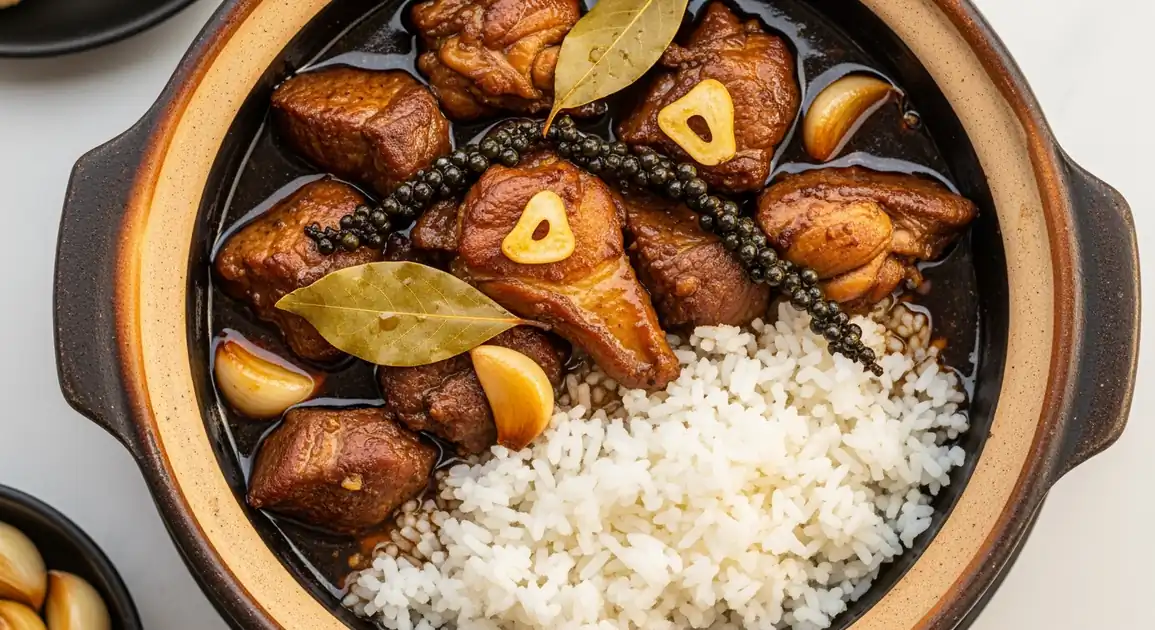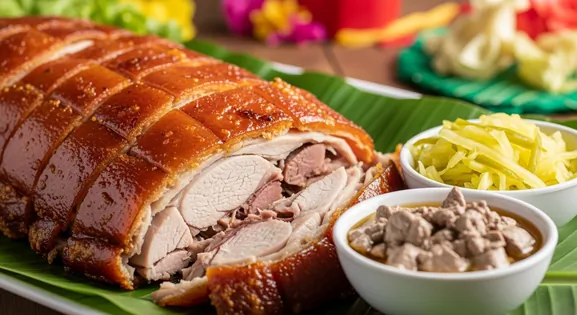Adobo in Manila
Adobo

A Beloved Local Dish
As a local, I've seen adobo evolve in Manila, yet its soul remains. From humble carinderias to upscale dining, each bite tells a story of Filipino heritage. Get ready to explore the capital's diverse adobo landscape, where tradition meets innovation in every savory, vinegary spoonful.
New to Adobo? Learn all about its history in our complete guide.
What the Locals Know
For the freshest and most authentic adobo experience, head to a local carinderia between 11 AM and 1 PM. High turnover ensures the adobo is newly cooked and at its best.
Many restaurants in the Malate area specialize in regional Filipino cuisine. Ask for their specific adobo variations, like Batangas or Bicolano styles, for a unique taste of the provinces.
Manila's Chinatown, Binondo, offers unique Chinese-Filipino adobo versions, often richer with star anise or mushrooms. Seek out established eateries for this distinct culinary fusion.
Top Spots for Adobo in Manila
Binondo (Manila Chinatown)
Manila's historic Chinatown, offering a unique blend of Filipino and Chinese culinary traditions. Here, you'll find some of the city's oldest eateries serving adobo with distinct Chinese-Filipino influences.
Lucky Chinatown Mall, Binondo Church, Ongpin Street
Lunch (11 AM - 2 PM), Dinner (6 PM - 9 PM)
Makati
A dynamic business district where you can find adobo ranging from quick, affordable street food stalls and 'jollijeeps' to sophisticated, upscale Filipino restaurants in modern malls.
Greenbelt, Glorietta, Salcedo Village, Poblacion
Lunch (12 PM - 2 PM), Dinner (7 PM - 10 PM)
Malate/Ermita
A vibrant tourist and entertainment hub known for its diverse array of restaurants, many of which proudly showcase traditional Filipino cuisine, including various regional adobo styles.
Robinsons Place Manila, Adriatico Circle, Remedios Circle
Lunch (11 AM - 2 PM), Dinner (6 PM - 10 PM)
University Belt
This bustling area is home to numerous universities and offers a plethora of budget-friendly carinderias and eateries, making it a prime spot for affordable and authentic adobo popular with students and locals.
University of Santo Tomas, Far Eastern University, San Beda University
Lunch (11 AM - 1 PM), Afternoon (3 PM - 6 PM)
Vendor Tips
- Look for places with 'Lutong Bahay' (home-cooked) signs for more authentic adobo.
- At carinderias, check if the adobo is freshly cooked or recently replenished.
- Restaurants that specialize in regional Filipino cuisine often have unique adobo variations worth trying.
- In Manila, many established restaurants are known specifically for their adobo - ask locals for recommendations.
Quality Checklist: How to Find the Best
What to Look For
-
Busy 'carinderias' (local eateries) with high customer turnover, especially during lunch hours in areas like Quiapo or university belts.
High turnover suggests food, including adobo, is cooked fresh and doesn't sit long.
-
Adobo kept in chafing dishes or pots that are visibly steaming or kept over a low heat source.
Helps keep the dish outside the temperature danger zone (4°C-60°C), important even for preserved dishes in Manila's heat.
-
Meat (chicken or pork) that is fork-tender and looks fully cooked through.
Ensures the meat is safely cooked.
-
Sauce that is glossy and slightly thickened, not watery or excessively oily.
Indicates proper reduction and preparation technique, a sign of quality.
What to avoid
-
Adobo sitting in pots or trays at ambient temperature for extended periods, especially in open-air carinderias.
Despite preservative properties, prolonged sitting in Manila's heat and humidity can still pose risks.
-
Carinderias with obvious signs of poor hygiene (flies, dirty surfaces, unclean utensils).
General cleanliness is paramount.
-
Meat that looks tough, dry, or stringy, or has parts that appear undercooked.
Indicates poor quality or unsafe cooking.
-
Adobo with an 'off' smell, beyond the expected vinegar and soy sauce aroma.
Could indicate spoilage, despite the strong marinade.
The Traveler's Essentials
Dietary Information
Important Note for Travelers: Your safety is our priority. Below are the common allergens associated with the traditional preparation of this dish. However, recipes and ingredients can vary significantly between establishments. Always confirm all ingredients directly with the food vendor before ordering, especially if you have a severe allergy.
Potential Allergens
Dietary Suitability
Price Guide
Budget Tips
- University belt carinderias around España, Recto, and Sampaloc offer student-friendly prices (90-150 PHP).
- Food courts in malls like SM or Robinson's have affordable adobo options (120-180 PHP).
- Jollijeeps (street food stalls) in Makati's business district serve quick, inexpensive adobo lunches.
- Set meals ('value meals') often include rice and a side dish.
Serving & Seasonality
Served in various ways depending on the establishment: in clay pots (palayok) at traditional restaurants, on sizzling plates at more modern venues, or in simple plastic/metal containers at carinderias. Always accompanied by rice.Best Times to Enjoy
- Lunch: Peak time for adobo at most establishments, when freshly made batches are typically available.
- Dinner: Popular evening option, especially at sit-down restaurants.
- Late Night: Available at 24-hour Filipino restaurants like Cafe Adriatico or select branches of Tapa King.
Seasonal Availability
Available year-round.
A Simple Guide to Ordering
When ordering adobo in Manila, remember it's always served with rice ('kanin'). Don't be shy to ask for extra sauce ('sarsa') if you prefer it saucier. At carinderias, simply point to the adobo ('turo-turo') you want. In sit-down restaurants, inquire about the specific type of adobo (chicken, pork, or mixed) and if they have any regional specialties. Locals often enjoy squeezing calamansi over their adobo for an added tangy kick.
A Look at Local Preparations
Manila-style Adobo
Often characterized by a balanced sauce that's neither too dry nor too soupy, with a good soy sauce-vinegar equilibrium.
Upscale Adobo
Found in Manila's high-end Filipino restaurants, featuring premium ingredients like organic free-range chicken, heritage pork, or specialty vinegars.
Fusion Adobo
Creative interpretations found in Manila's modern restaurants, including adobo tacos, adobo pasta, adobo pizza, adobo sushi, and adobo burgers.
Chinese-Filipino Adobo
Versions influenced by Chinese-Filipino cooking, often incorporating star anise, mushrooms, or Chinese cooking wine.
Culture and Customs
Local Significance
In Manila, adobo represents both tradition and innovation - a dish that connects urbanites to their provincial roots while evolving with the city's dynamic food scene.
Eating Customs
- In Manila restaurants, adobo is often eaten with a local side dish like ensaladang talong (eggplant salad) or atchara (pickled papaya).
- Some Manila locals enjoy adobo with calamansi (local citrus) squeezed over the meat.
- Urban Manila dwellers often debate which regional adobo style is superior.
Practical Guides for Enjoying Adobo
Navigating Manila Carinderias for Classic Adobo
Learn how to confidently navigate Manila's bustling carinderias to find delicious and authentic adobo, ensuring a truly local culinary experience while making smart choices.
- Target popular carinderias during peak lunch hours (11 AM - 1 PM) for the freshest food. Areas like near LRT/MRT stations or public markets often have many options.
- Look at the 'turo-turo' (point-point) display; observe if the adobo pot is being kept warm or if turnover is high.
- Choose places that look clean and are frequented by locals (office workers, students).
- Check the meat's appearance – it should look tender and well-cooked in a glossy sauce.
- Order a single serving ('isang order') with rice ('kanin').
How to Identify Different Adobo Styles in Manila
Become an expert in identifying the diverse adobo styles prevalent across Manila, from traditional regional interpretations to modern, fusion-inspired creations.
- Look for 'Adobong Puti' (White Adobo) made without soy sauce, relying only on vinegar, garlic, and salt/patis – lighter color.
- Identify 'Adobong Dilaw' (Yellow Adobo) using turmeric ('luyang dilaw'), common in Batangas style sometimes found in Manila.
- Notice variations in meat: Chicken ('manok'), Pork ('baboy'), or mixed. Some places offer 'Adobong Pusit' (squid) or 'Adobong Kangkong' (water spinach).
- Observe sauce consistency: some Manila versions are saucier ('masabaw'), others drier ('tuyo').
- Ask the vendor ('Anong klaseng adobo po ito?') if unsure about the style.
Our Commitment to Quality
At Tasteplorers, our mission is to provide the most accurate and useful travel information in the world. To achieve this, all content on this site is created through our unique editorial framework. We utilize leading AI research tools, guided by our proprietary prompts, and a multi-stage validation process. This entire system is overseen by our editorial team to ensure everything we publish meets our high standards for accuracy, cultural nuance, and practical value for travelers.
Learn more about our Editorial Process and our Mission.
Countries
Explore regions
Europe
Discover Europe's diverse culinary landscape, from Mediterranean flavors to hearty Alpine fare. Learn to navigate markets, decode menus, and eat like a local.
Latin America & Caribbean
Discover the vibrant cuisines of Latin America & the Caribbean. Our expert guide covers everything from Mexican street food to Peruvian ceviche and market tips.
Oceania
Explore Oceania's diverse food scene. Learn about Polynesian earth ovens, Fijian feasts, and the vibrant café culture of Australia and New Zealand.
Southeast Asia
Explore Southeast Asia's diverse food cultures from Thailand to Vietnam. Get expert tips on navigating spice levels, choosing quality vendors, and understanding the rich traditions of the region.



